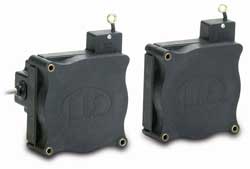
Posted to News on 13th Sep 2009, 16:04
Draw-wire sensors chosen for medical applications
Chris Jones, Managing Director of Micro-Epsilon (UK) Ltd, discusses how draw-wire displacement ('string pot') sensors are used for critical applications in medical operating theatres, including X-ray machines, CT scanners, patient tables and flexible surgical arms.

Utilisation and cost-efficiency are now just as important to medical operating theatres as they have always been to manufacturing companies. The latest operating tables, for example, offer numerous functions for precise handling of the patient, yet they must also be efficient and cost-effective.
Typically operating tables are modular in design and offer multiple adjustment options for the precise positioning of the patient during an operation. As well as the height of the table, the horizontal position and several angular functions for the head, torso and legs need to be adjustable.
In order to enable these adjustments to be made, suitable measuring devices are required. Draw-wire displacement sensors (often called 'string pot' sensors or cable extension sensors) are useful for this, as they combine a compact design with high precision and a long service life. The sensors can integrate easily with the operating table, offering an excellent price/performance ratio.
How draw-wire sensors work
The principle of a draw-wire displacement sensor is relatively straightforward, hence its inherent reliability. The sensor works rather like a tape measure, except that with a draw-wire sensor the user does not have to read the measurement from the extended tape; instead the rotation of the drum on which the steel wire is wound is measured automatically and the measurement signal is output as either an analogue or digital signal. The drum itself incorporates a long-life spring drive that ensures the steel wire is rewound.
X-ray machines also require precise positioning so that they can provide high-quality images. The digital camera on these machines has to be aligned exactly with the X-ray tubes so that high-resolution recordings can be produced. The cameras, X-ray tubes, table and wall stands can be moved on several axes, providing plenty of flexibility.
Draw-wire sensors can be used to position the mechanical moving parts. The synchronisation controller in the X-ray unit then uses the displacement data from the sensors to ensure that the X-ray tube and camera move parallel to each other.
Similarly, CT (computed tomography) equipment requires fast, precise but cost-effective measurement systems. Spiral, helical and dual-source CT systems all require precise, fast sensors. In particular, the length measurement for the horizontal reclined position is important. In order to obtain the best possible overall image of the target, the individual X-ray sections, which normally travel through the object, have to be measured with smaller and smaller spacing. To do this, the sections are compiled in a 3D model to obtain voxels (volumetric pixels). Based on this complete volume data set, any 3D views or sectional planes can be produced. In order to align the sections correctly, the horizontal position of the couch must be measured precisely. Therefore a measuring system with very high resolution and long range is required. Draw-wire sensors can offer resolutions down to 0.001 per cent of the measuring range, so are highly suitable for this application.
Angular measurements

With such equipment the arm must be immune to MR (magnetic resonance) and X-rays, hence many types of sensor cannot be used in the area directly above the operating table. Direct measurement of the angular movements of the arm with angle sensors is therefore not possible. However, the angle of rotation can be measured indirectly by using draw-wire sensors installed underneath the operating table. Several sensors are required, which provide either an angle-proportional output signal (potentiometer) or a digital incremental output.
Follow the link for more information about Micro-Epsilon's range of draw-wire displacement sensors. Alternatively, telephone +44 (0)151 355 6070 or email [email protected].
No. 1 Shorelines Building
Shore Road
CH41 1AU
UNITED KINGDOM
+44 (0)151 355 6070






























